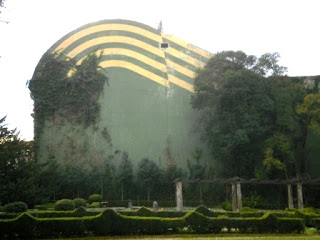The Santina is a statue of the Virgin in a cave in the Picos de Europa. This is one of the most popular tourist destinations in Asturias due to the symbolic importance of Covadonga in the national mythology of Spain.
When the Muslims invaded in 711 they rapidly overran the whole peninsula forcing the surviving Visigothic nobles to find refuge in the most mountainous and inaccessible areas of the north. Covadonga is the site of the first battle in the Christian resistance. Legend says that Pelayo successfully beat off a vastly superior army that was on a punitive raid to enforce the payment of taxes: with divine help of course.
Covadonga:
cueva de la Madonna; cave of the Virgin. Water spurts out of the mountainside into a pool below the cave from where the diminutive chapel of the Virgin looks out across the valley. The thousands of coins pilgrims have thrown into the water pay testimony to people's continuing belief in the power of the Virgin to miraculously intervene in their lives.
On a rocky outcrop opposite the cave is a neo-Romanesque church completed in 1901. The air inside is thick with incense and there is the sound of amplified choral singing coming from hidden speakers as you approach the altar where a cross is dramatically illuminated from below. The Cross of Victory, a 10th century jewel-encrusted processional cross, is now in Oviedo, but it is indelibly associated with Covadonga and the nearby town of Cangas de Onís where another cross hangs under the ancient Roman bridge. They say Pelayo took the original into battle with him.
As times change foundational myths change. Modern archaeolgoists have discovered a dolmen below the chapel of Santa Cruz in Cangas. Contemporary tastes look further into the past for the roots of Asturianismo: cave paintings, engraved stones, and the omnipresent
trisquel, a three-armed figure with rounded ends that everyone connects with Celtic origins. It has come to replace the cross as the talismanic totem of preference for modern people.
Now people like to believe that Covadonga was a pre-Christian religious site and that the word does not refer to the Madonna but to a sacred pool used in antique rituals.
As we drove away past the modern carparks, the
fabada restaurants with their play areas and picnic tables, and the canoeing centre with its ranks of plastic kayaks, we could reflect on the connections of all this modernity with the deeper past. The well-preserved villages with their barns and tile roofs are not swamped by modern concrete buildings and open up a vision to slower times. Even the plantations of eucalyptus and pine cannot detract from the evocative winter light on the snow-clad peaks.
We came away with the image of the Santina and a trisquel in our minds and cannot escape meditating on the fact that the experience was numinous, drawing us to think about human connections across centuries of dividing time. These connections can remain alive with something as fragile and mutable as an image. It is thought-provoking.
























